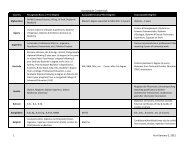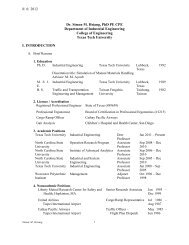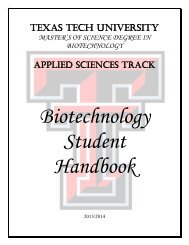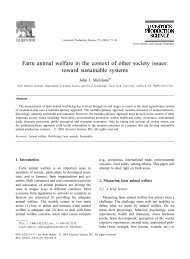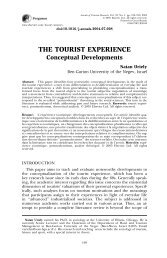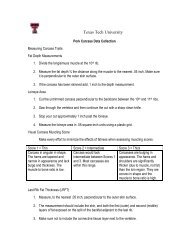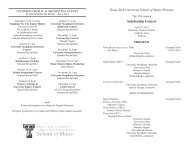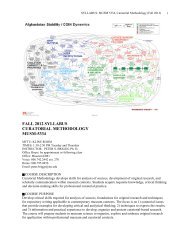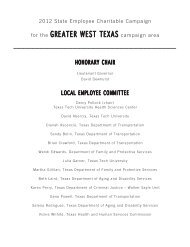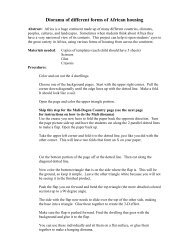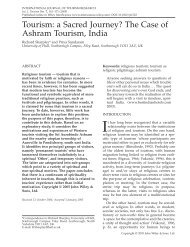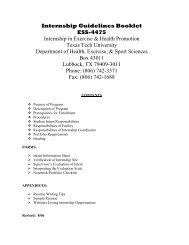PHY 1A - Texas Tech University
PHY 1A - Texas Tech University
PHY 1A - Texas Tech University
Create successful ePaper yourself
Turn your PDF publications into a flip-book with our unique Google optimized e-Paper software.
<strong>PHY</strong>SICS <strong>1A</strong><br />
Physics I, First Semester<br />
#8721 (v.3.0)<br />
To the Student:<br />
After your registration is complete and your proctor has been approved, you may take the<br />
Credit by Examination for Physics <strong>1A</strong>.<br />
WHAT TO BRING<br />
� several sharpened No. 2 pencils<br />
� calculator<br />
� small metric ruler<br />
� lined notebook paper<br />
ABOUT THE EXAM<br />
The examination for the first semester of Physics consists of 50 questions, of which 38-39<br />
are multiple choice and 11-12 are short-answer or problem-solving. The exam is based on<br />
the <strong>Texas</strong> Essential Knowledge and Skills (TEKS) for this subject. The full list of TEKS is<br />
included in this document (it is also available online at the <strong>Texas</strong> Education Agency<br />
website, http://www.tea.state.tx.us/). The TEKS outline specific topics covered in the<br />
exam, as well as more general areas of knowledge and levels of critical thinking. Use the<br />
TEKS to focus your study in preparation for the exam.<br />
The CBE for Physics <strong>1A</strong> must be completed in one sitting without aid from persons, notes,<br />
or textbooks, but you may use a calculator and a formula sheet (provided with the exam)<br />
during the entire examination. All answers should be given in the spaces provided on the<br />
answer sheet. Where appropriate, show essential steps for the solutions of problems,<br />
clearly indicate answers, and give appropriate units.<br />
The examination will take place under supervision, and the recommended time limit is<br />
three hours. A percentage score from the examination will be reported to the official at<br />
your school.<br />
In preparation for the examination, review the TEKS for this subject. All TEKS are<br />
assessed. It is important to prepare adequately. Since questions are not taken from any<br />
one course, you can prepare by reviewing any of the state-adopted textbooks that are used<br />
at your school. The textbook used with our Physics <strong>1A</strong> course are:<br />
Hewitt, Paul G. (2002). Conceptual Physics. New Jersey: Prentice-Hall, Inc. ISBN<br />
0-13-054254-7<br />
Hewitt, Paul G. (2002). Concept-Development Practice Book. New Jersey: Prentice<br />
Hall, Inc. ISBN 0-13-054259-8.<br />
For more information about CBE policies, visit http://www.help.k12.ttu.edu/.<br />
Good luck on your examination!<br />
3/12 www.k12.ttu.edu
Physics <strong>1A</strong> Overview<br />
Physics is a course in which the successful student will learn to understand, explain, and<br />
calculate the effects of nature. Concepts covered are motion, forces, energy, behavior of<br />
matter, and transfer of thermal energy. The student will apply concepts by answering<br />
questions, calculating values, and performing experiments to deepen their understanding of<br />
their physics knowledge.<br />
In Physics <strong>1A</strong>, you will:<br />
� Conduct investigations using safe, environmentally appropriate, and ethical<br />
practices.<br />
� Use a systematic approach to answer scientific laboratory and field investigative<br />
questions.<br />
� Use critical thinking, scientific reasoning, and problem solving to make informed<br />
decisions within and outside the classroom.<br />
� Know and apply the laws governing motion in a variety of situations.<br />
� Understand the nature of forces in the physical world.<br />
� Understand that changes occur within a physical system and apply the laws of<br />
conservation of energy and momentum.<br />
2
<strong>Texas</strong> Essential Knowledge and Skills<br />
Physics 1<br />
§112.39. Physics, Beginning with School Year 2010-2011 (One Credit).<br />
(a) General requirements. Students shall be awarded one credit for successful completion of this course. Algebra I is suggested as a<br />
prerequisite or co-requisite. This course is recommended for students in Grade 9, 10, 11, or 12.<br />
(b) Introduction.<br />
(1) Physics. In Physics, students conduct laboratory and field investigations, use scientific methods during investigations, and make<br />
informed decisions using critical thinking and scientific problem solving. Students study a variety of topics that include: laws of motion;<br />
changes within physical systems and conservation of energy and momentum; forces; thermodynamics; characteristics and behavior of<br />
waves; and atomic, nuclear, and quantum physics. Students who successfully complete Physics will acquire factual knowledge within a<br />
conceptual framework, practice experimental design and interpretation, work collaboratively with colleagues, and develop critical<br />
thinking skills.<br />
(2) Nature of science. Science, as defined by the National Academy of Sciences, is the "use of evidence to construct testable<br />
explanations and predictions of natural phenomena, as well as the knowledge generated through this process." This vast body of<br />
changing and increasing knowledge is described by physical, mathematical, and conceptual models. Students should know that some<br />
questions are outside the realm of science because they deal with phenomena that are not scientifically testable.<br />
(3) Scientific inquiry. Scientific inquiry is the planned and deliberate investigation of the natural world. Scientific methods of<br />
investigation can be experimental, descriptive, or comparative. The method chosen should be appropriate to the question being asked.<br />
(4) Science and social ethics. Scientific decision making is a way of answering questions about the natural world. Students should be<br />
able to distinguish between scientific decision-making methods and ethical and social decisions that involve the application of scientific<br />
information.<br />
(5) Scientific systems. A system is a collection of cycles, structures, and processes that interact. All systems have basic properties that<br />
can be described in terms of space, time, energy, and matter. Change and constancy occur in systems as patterns and can be observed,<br />
measured, and modeled. These patterns help to make predictions that can be scientifically tested. Students should analyze a system in<br />
terms of its components and how these components relate to each other, to the whole, and to the external environment.<br />
(c) Knowledge and skills.<br />
(1) Scientific processes. The student conducts investigations, for at least 40% of instructional time, using safe, environmentally<br />
appropriate, and ethical practices. These investigations must involve actively obtaining and analyzing data with physical equipment, but<br />
may also involve experimentation in a simulated environment as well as field observations that extend beyond the classroom. The<br />
student is expected to:<br />
(A) demonstrate safe practices during laboratory and field investigations; and<br />
(B) demonstrate an understanding of the use and conservation of resources and the proper disposal or recycling of materials.<br />
(2) Scientific processes. The student uses a systematic approach to answer scientific laboratory and field investigative questions. The<br />
student is expected to:<br />
(A) know the definition of science and understand that it has limitations, as specified in subsection (b)(2) of this section;<br />
(B) know that scientific hypotheses are tentative and testable statements that must be capable of being supported or not supported by<br />
observational evidence. Hypotheses of durable explanatory power which have been tested over a wide variety of conditions are<br />
incorporated into theories;<br />
(C) know that scientific theories are based on natural and physical phenomena and are capable of being tested by multiple independent<br />
researchers. Unlike hypotheses, scientific theories are well-established and highly-reliable explanations, but may be subject to change as<br />
new areas of science and new technologies are developed;<br />
(D) distinguish between scientific hypotheses and scientific theories;<br />
(E) design and implement investigative procedures, including making observations, asking well-defined questions, formulating testable<br />
hypotheses, identifying variables, selecting appropriate equipment and technology, and evaluating numerical answers for<br />
reasonableness;<br />
(F) demonstrate the use of course apparatus, equipment, techniques, and procedures, including multimeters (current, voltage,<br />
resistance), triple beam balances, batteries, clamps, dynamics demonstration equipment, collision apparatus, data acquisition probes,<br />
discharge tubes with power supply (H, He, Ne, Ar), hand-held visual spectroscopes, hot plates, slotted and hooked lab masses, bar<br />
magnets, horseshoe magnets, plane mirrors, convex lenses, pendulum support, power supply, ring clamps, ring stands, stopwatches,<br />
trajectory apparatus, tuning forks, carbon paper, graph paper, magnetic compasses, polarized film, prisms, protractors, resistors, friction<br />
blocks, mini lamps (bulbs) and sockets, electrostatics kits, 90-degree rod clamps, metric rulers, spring scales, knife blade switches,<br />
Celsius thermometers, meter sticks, scientific calculators, graphing technology, computers, cathode ray tubes with horseshoe magnets,<br />
ballistic carts or equivalent, resonance tubes, spools of nylon thread or string, containers of iron filings, rolls of white craft paper, copper<br />
wire, Periodic Table, electromagnetic spectrum charts, slinky springs, wave motion ropes, and laser pointers;<br />
3
(G) use a wide variety of additional course apparatus, equipment, techniques, materials, and procedures as appropriate such as ripple<br />
tank with wave generator, wave motion rope, micrometer, caliper, radiation monitor, computer, ballistic pendulum, electroscope,<br />
inclined plane, optics bench, optics kit, pulley with table clamp, resonance tube, ring stand screen, four inch ring, stroboscope, graduated<br />
cylinders, and ticker timer;<br />
(H) make measurements with accuracy and precision and record data using scientific notation and International System (SI) units;<br />
(I) identify and quantify causes and effects of uncertainties in measured data;<br />
(J) organize and evaluate data and make inferences from data, including the use of tables, charts, and graphs;<br />
(K) communicate valid conclusions supported by the data through various methods such as lab reports, labeled drawings, graphic<br />
organizers, journals, summaries, oral reports, and technology-based reports; and<br />
(L) express and manipulate relationships among physical variables quantitatively, including the use of graphs, charts, and equations.<br />
(3) Scientific processes. The student uses critical thinking, scientific reasoning, and problem solving to make informed decisions within<br />
and outside the classroom. The student is expected to:<br />
(A) in all fields of science, analyze, evaluate, and critique scientific explanations by using empirical evidence, logical reasoning, and<br />
experimental and observational testing, including examining all sides of scientific evidence of those scientific explanations, so as to<br />
encourage critical thinking by the student;<br />
(B) communicate and apply scientific information extracted from various sources such as current events, news reports, published<br />
journal articles, and marketing materials;<br />
(C) draw inferences based on data related to promotional materials for products and services;<br />
(D) explain the impacts of the scientific contributions of a variety of historical and contemporary scientists on scientific thought and<br />
society;<br />
(E) research and describe the connections between physics and future careers; and<br />
(F) express and interpret relationships symbolically in accordance with accepted theories to make predictions and solve problems<br />
mathematically, including problems requiring proportional reasoning and graphical vector addition.<br />
(4) Science concepts. The student knows and applies the laws governing motion in a variety of situations. The student is expected to:<br />
(A) generate and interpret graphs and charts describing different types of motion, including the use of real-time technology such as<br />
motion detectors or photogates;<br />
(B) describe and analyze motion in one dimension using equations with the concepts of distance, displacement, speed, average velocity,<br />
instantaneous velocity, and acceleration;<br />
(C) analyze and describe accelerated motion in two dimensions using equations, including projectile and circular examples;<br />
(D) calculate the effect of forces on objects, including the law of inertia, the relationship between force and acceleration, and the nature<br />
of force pairs between objects;<br />
(E) develop and interpret free-body force diagrams; and<br />
(F) identify and describe motion relative to different frames of reference.<br />
(5) Science concepts. The student knows the nature of forces in the physical world. The student is expected to:<br />
(A) research and describe the historical development of the concepts of gravitational, electromagnetic, weak nuclear, and strong nuclear<br />
forces;<br />
(B) describe and calculate how the magnitude of the gravitational force between two objects depends on their masses and the distance<br />
between their centers;<br />
(C) describe and calculate how the magnitude of the electrical force between two objects depends on their charges and the distance<br />
between them;<br />
(D) identify examples of electric and magnetic forces in everyday life;<br />
(E) characterize materials as conductors or insulators based on their electrical properties;<br />
(F) design, construct, and calculate in terms of current through, potential difference across, resistance of, and power used by electric<br />
circuit elements connected in both series and parallel combinations;<br />
(G) investigate and describe the relationship between electric and magnetic fields in applications such as generators, motors, and<br />
transformers; and<br />
(H) describe evidence for and effects of the strong and weak nuclear forces in nature.<br />
(6) Science concepts. The student knows that changes occur within a physical system and applies the laws of conservation of energy<br />
and momentum. The student is expected to:<br />
(A) investigate and calculate quantities using the work-energy theorem in various situations;<br />
4
(B) investigate examples of kinetic and potential energy and their transformations;<br />
(C) calculate the mechanical energy of, power generated within, impulse applied to, and momentum of a physical system;<br />
(D) demonstrate and apply the laws of conservation of energy and conservation of momentum in one dimension;<br />
(E) describe how the macroscopic properties of a thermodynamic system such as temperature, specific heat, and pressure are related to<br />
the molecular level of matter, including kinetic or potential energy of atoms;<br />
(F) contrast and give examples of different processes of thermal energy transfer, including conduction, convection, and radiation; and<br />
(G) analyze and explain everyday examples that illustrate the laws of thermodynamics, including the law of conservation of energy and<br />
the law of entropy.<br />
(7) Science concepts. The student knows the characteristics and behavior of waves. The student is expected to:<br />
(A) examine and describe oscillatory motion and wave propagation in various types of media;<br />
(B) investigate and analyze characteristics of waves, including velocity, frequency, amplitude, and wavelength, and calculate using the<br />
relationship between wavespeed, frequency, and wavelength;<br />
(C) compare characteristics and behaviors of transverse waves, including electromagnetic waves and the electromagnetic spectrum, and<br />
characteristics and behaviors of longitudinal waves, including sound waves;<br />
(D) investigate behaviors of waves, including reflection, refraction, diffraction, interference, resonance, and the Doppler effect;<br />
(E) describe and predict image formation as a consequence of reflection from a plane mirror and refraction through a thin convex lens;<br />
and<br />
(F) describe the role of wave characteristics and behaviors in medical and industrial applications.<br />
(8) Science concepts. The student knows simple examples of atomic, nuclear, and quantum phenomena. The student is expected to:<br />
(A) describe the photoelectric effect and the dual nature of light;<br />
(B) compare and explain the emission spectra produced by various atoms;<br />
(C) describe the significance of mass-energy equivalence and apply it in explanations of phenomena such as nuclear stability, fission,<br />
and fusion; and<br />
(D) give examples of applications of atomic and nuclear phenomena such as radiation therapy, diagnostic imaging, and nuclear power<br />
and examples of applications of quantum phenomena such as digital cameras.<br />
Source: The provisions of this §112.39 adopted to be effective August 4, 2009, 34 TexReg 5063.<br />
5
Physics <strong>1A</strong> Sample Final Examination<br />
In the blank provided, write the letter preceding the word or phrase that best<br />
completes the statement.<br />
_____ 1. Mechanics includes the study of<br />
A. motion.<br />
B. waves.<br />
C. heat.<br />
D. light.<br />
_____ 2. Which of these measurements has a different number of significant figures<br />
than the others?<br />
A. 105,000 km<br />
B. 0.000204 kg<br />
C. 57.0 s<br />
D. 8.6 L<br />
_____ 3. The most significant form of energy possessed by a bowling ball rolling down<br />
the alley is<br />
A. potential energy.<br />
B. kinetic energy.<br />
C. heat energy.<br />
D. sound energy.<br />
_____ 4. A book resting on a table top has potential energy<br />
A. if the table top is level.<br />
B. if the book is pushed off the table.<br />
C. if the table top is above the arbitrary zero level.<br />
D. if the table is 0.70 m high.<br />
_____ 5. The relationship between heat and work was first demonstrated by<br />
A. Rumford.<br />
B. Charles.<br />
C. Galileo.<br />
D. Joule.<br />
_____ 6. Two vectors of unequal magnitude act at right angles to one another. The<br />
magnitude of the resultant may be<br />
A. smaller than that of either vector.<br />
B. between the magnitudes of the two component vectors.<br />
C. equal to the magnitude of the larger vector.<br />
D. larger than that of either vector.<br />
6
_____ 7. One liter is not equal to<br />
A. 0.01 kL.<br />
B. 1000 mL.<br />
C. 1 dm 3 .<br />
D. 1000 cm 3 .<br />
_____ 8. A wooden cube is 4.0 cm on a side. It has a mass of 32 g. The mass density<br />
of water is 1.0 g/cm 3 . The specific gravity of the cube is<br />
A. 0.50.<br />
B. 8.0.<br />
C. 0.12.<br />
D. 2.0.<br />
_____ 9. Speed is<br />
A. the same as velocity.<br />
B. the ratio of distance divided by time.<br />
C. a vector quantity.<br />
D. expressed in m/s 2 .<br />
_____ 10. A stationary object remains stationary and a moving object continues to move<br />
because of<br />
A. inertia.<br />
B. gravity.<br />
C. force.<br />
D. mass.<br />
_____ 11. Newton’s first law of motion<br />
A. deals with the effect of an unbalanced force on a body.<br />
B. is known as the law of inertia.<br />
C. involves two forces and two objects.<br />
D. involves the concepts of force, mass, and acceleration.<br />
_____ 12. The motion of an object thrown vertically upward is affected by the<br />
acceleration of gravity<br />
A. during its upward motion only.<br />
B. during its downward motion only.<br />
C. during both its upward and downward motions.<br />
D. in a variable manner.<br />
_____ 13. Two or more forces acting at the same time on the same point are<br />
A. concurrent forces.<br />
B. parallel forces.<br />
C. resultant forces.<br />
D. equilibrant forces.<br />
7
_____ 14. A body is not in equilibrium if<br />
A. it is moving at a constant speed in a straight line.<br />
B. there is an unbalanced force acting on the body.<br />
C. it is at rest.<br />
D. its motion is unchanged.<br />
_____ 15. A single force is usually resolved into two forces having an angle between<br />
them of __________ degrees.<br />
A. 30<br />
B. 45<br />
C. 60<br />
D. 90<br />
_____ 16. Which of the following statements about friction is false?<br />
A. Friction involves objects that are in physical contact.<br />
B. Friction is less if surfaces are very smooth.<br />
C. Friction is a force that resists motion.<br />
D. Friction is caused by the uneven surfaces of touching objects.<br />
_____ 17. An example of periodic motion is a<br />
A. merry-go-round.<br />
B. swing.<br />
C. see-saw.<br />
D. roller coaster.<br />
_____ 18. The time of one complete vibration is the<br />
A. amplitude.<br />
B. dispacement.<br />
C. frequency.<br />
D. period.<br />
_____ 19. An object moves horizontally at constant speed but is subject to a vertically<br />
downward acceleration. The path of the object is<br />
A. straight horizontal.<br />
B. straight vertical.<br />
C. straight diagonal.<br />
D. none of these.<br />
_____ 20. For an object moving in a vertical circular path in the presence of gravity,<br />
A. the velocity of the object is greatest at the top of the circle.<br />
B. the velocity of the object is greatest at the bottom of the circle.<br />
C. the centripetal force is a maximum at the top of the circle.<br />
D. the centripetal force is a minimum at the bottom of the circle.<br />
8
_____ 21. The two basic types of machines are<br />
A. pulley and wheel and axle.<br />
B. lever and inclined plane.<br />
C. pulley and wedge.<br />
D. wedge and screw.<br />
9
v f - vo<br />
Acceleration: a =<br />
t<br />
Velocity:<br />
Free fall:<br />
d<br />
v = t<br />
1<br />
d = gt<br />
2<br />
2<br />
vv = vo + gt<br />
vf 2 = vo 2 + 2gd<br />
Vector components:<br />
opposite<br />
sinθ = hypotenuse<br />
adjacent<br />
cosθ = hypotenuse<br />
opposite<br />
tanθ = adjacent<br />
Newton’s Law: F = ma<br />
Pressure:<br />
F<br />
P = A<br />
Momentum: p = mv<br />
Collision: m1v1o + m2v2o = m1v1f + m2v2f<br />
Work: W = Fd<br />
Power:<br />
W<br />
P = t<br />
Energy: potential energy PE = mgh<br />
kinetic energy KE = ½mv 2<br />
Formulas and Constants<br />
10
Mechanical advantage:<br />
din<br />
ideal (neglecting friction): IMA =<br />
d<br />
Fout<br />
actual (including friction): AMA =<br />
F<br />
GmM<br />
Universal gravitation: F = 2<br />
d<br />
Constants:<br />
GM<br />
g = 2<br />
d<br />
G = 6.67 � 10 -11 N·m 2 /kg 2<br />
c = 3 � 10 8 m/s<br />
g on Earth = 9.81 m/s 2<br />
11<br />
out<br />
in
Physics <strong>1A</strong> Sample Exam<br />
Answer Key<br />
1. A<br />
2. D<br />
3. B<br />
4. C<br />
5. D<br />
6. D<br />
7. A<br />
8. A<br />
9. B<br />
10. A<br />
11. B<br />
12. C<br />
13. A<br />
14. B<br />
12<br />
15. D<br />
16. B<br />
17. B<br />
18. D<br />
19. D<br />
20. B<br />
21. B



